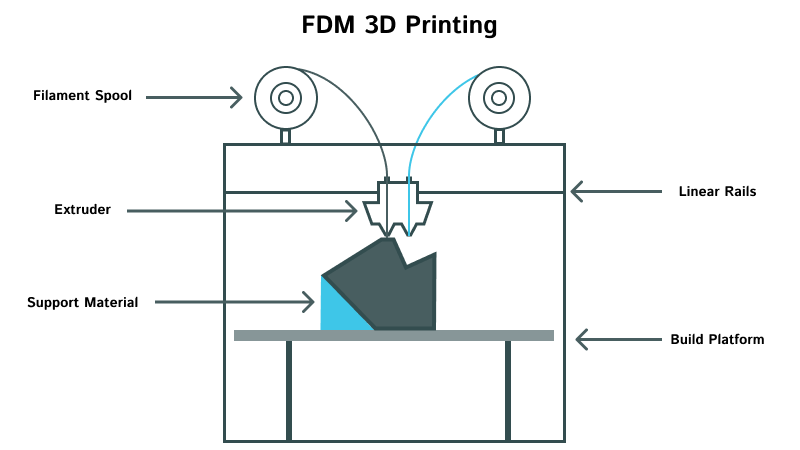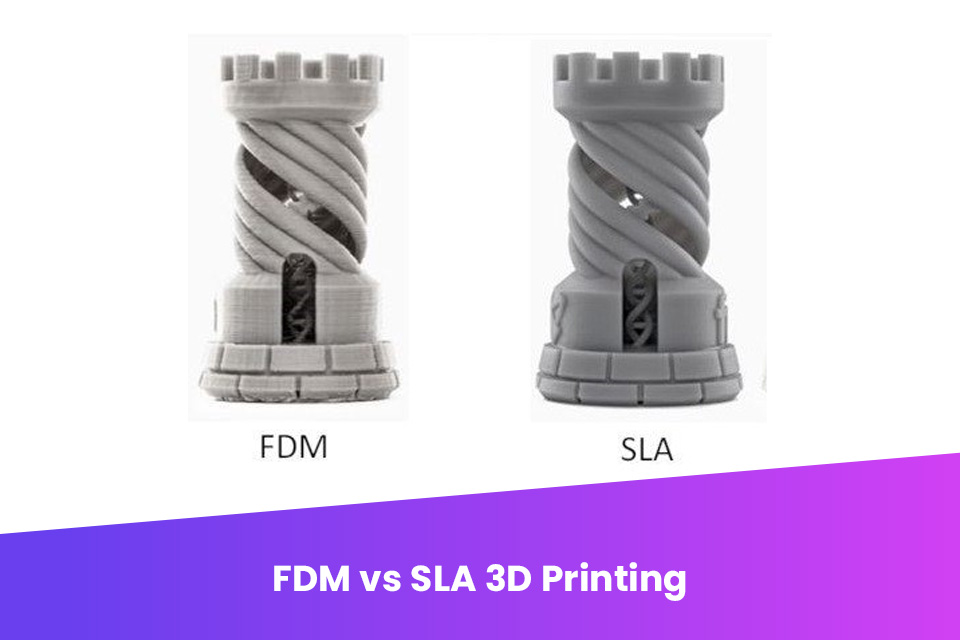In the world of rapid prototyping and custom manufacturing, 3D printing has become a game-changer for product designers, engineers, and R&D teams. Among the many 3D printing technologies available, Fused Deposition Modeling (FDM) and Stereolithography (SLA) stand out as two of the most popular options. But how do you decide which one is right for your project? In this detailed comparison of FDM vs. SLA, we'll explore their differences, advantages, limitations, and ideal use cases to help you make an informed decision. Whether you're a startup validating a new product or an automotive company prototyping complex parts, this guide is tailored to your needs.
What is FDM 3D Printing?
How FDM Works
Fused Deposition Modeling (FDM) is an additive manufacturing process that builds parts layer by layer by extruding molten thermoplastic filament through a heated nozzle. The material is deposited onto a build platform, where it cools and solidifies, gradually forming the final object. FDM is widely known for its affordability and versatility, making it a go-to choice for hobbyists and professionals alike.

Materials Used in FDM
FDM printers work with a variety of thermoplastics, including:
1. PLA (Polylactic Acid): Affordable, biodegradable, and easy to print, ideal for basic prototypes.
2. ABS (Acrylonitrile Butadiene Styrene): Durable and impact-resistant, suitable for functional parts.
3. PETG (Polyethylene Terephthalate Glycol): Combines strength and flexibility, great for mechanical components.
4. TPU (Thermoplastic Polyurethane): Flexible and elastic, perfect for wearables or soft parts.
Advanced FDM printers can also handle engineering-grade materials like nylon, polycarbonate, and carbon fiber composites for higher strength and heat resistance.
Advantages of FDM
1. Cost-Effective: FDM printers and materials are relatively inexpensive, making it accessible for small-batch production and prototyping.
2. Wide Material Selection: Offers a broad range of thermoplastics for diverse applications.
3. Large Build Volumes: FDM printers often have larger build areas, allowing for bigger parts in a single print.
4. Ease of Use: Simple setup and operation make it beginner-friendly.
Limitations of FDM
1. Surface Finish: FDM parts often have visible layer lines, requiring post-processing (sanding, painting) for a smooth finish.
2. Precision: Compared to other methods, FDM has lower resolution and accuracy, especially for intricate details.
3. Support Structures: Overhangs and complex geometries require support material, which can leave marks after removal.
What is SLA 3D Printing?
How SLA Works
Stereolithography (SLA) is a resin-based 3D printing technology that uses a UV laser to cure liquid photopolymer resin into solid layers. The laser traces each layer's design onto the surface of the resin vat, hardening it precisely before the build platform moves to allow the next layer to form. SLA is renowned for its exceptional detail and smooth finishes, making it a favorite in industries like medical devices and jewelry.

Materials Used in SLA
SLA printers use photopolymer resins, which come in various formulations:
1. Standard Resins: Affordable and versatile for general prototyping.
2. Tough Resins: Mimic the properties of ABS for durable parts.
3. Flexible Resins: Offer elasticity for soft-touch applications.
4. High-Temperature Resins: Resist heat for molds or industrial components.
5. Biocompatible Resins: Certified for medical and dental use.
Advantages of SLA
1. High Precision: SLA delivers intricate details and tight tolerances, ideal for small, complex parts.
2. Smooth Surface Finish: Parts come out with a polished look straight from the printer, minimizing post-processing.
3. Material Variety: Specialized resins cater to niche applications like dental or engineering needs.
Limitations of SLA
1. Higher Cost: SLA printers and resins are more expensive than FDM options.
2. Smaller Build Volume: Most SLA machines have limited print areas, restricting part size.
3. Post-Processing Requirements: Parts require washing in isopropyl alcohol and UV curing, adding time and effort.
4. Fragility: Resin parts can be brittle compared to some FDM thermoplastics.
Key Differences Between FDM and SLA
To help you choose between FDM and SLA, let's break down their differences across critical factors.
1. Accuracy and Resolution
1. FDM: Layer heights typically range from 100-300 microns, resulting in visible layer lines and lower resolution. It's suitable for larger, less detailed parts.
2. SLA: Achieves layer heights as low as 25-50 microns, offering superior detail and precision for intricate designs.
Winner: SLA for precision-driven projects.
2. Surface Finish
1. FDM: Produces a rougher finish that often requires sanding or chemical smoothing.
2. SLA: Delivers a glass-like surface right out of the printer, reducing finishing time.
Winner: SLA for aesthetics and minimal post-processing.
3. Material Options
1. FDM: Offers a broader range of thermoplastics, including flexible and high-strength options.
2. SLA: Focuses on resins with specialized properties but fewer overall choices.
Winner: FDM for material versatility.
4. Cost Considerations
1. FDM: Lower upfront costs for printers (starting at $200-$500) and materials ($20-$50/kg).
2. SLA: Higher costs for machines ($1,000+) and resins ($50-$150/liter).
Winner: FDM for budget-conscious projects.
5. Build Volume
1. FDM: Larger build areas (up to 400 x 400 x 400 mm or more) make it ideal for big parts.
2. SLA: Smaller build volumes (typically 150 x 150 x 200 mm) limit part size.
Winner: FDM for larger prototypes.
6. Strength and Durability
1. FDM: Thermoplastics like ABS and nylon provide robust, functional parts.
2. SLA: Resin parts excel in detail but may lack the toughness of FDM materials.
Winner: FDM for functional, load-bearing components.
When to Use FDM vs. SLA

Your choice between FDM and SLA depends on your project's specific needs. Here's a breakdown of ideal use cases.
Best Applications for FDM
1. Functional Prototypes: Test mechanical parts like gears or housings where strength matters more than aesthetics.
2. Large Parts: Print oversized components that don't fit in SLA machines.
3. Cost-Sensitive Projects: Perfect for startups or teams needing quick, affordable iterations.
4. Hobbyist Creations: DIY projects or models that don't require fine details.
Best Applications for SLA
1. Detailed Prototypes: Create intricate designs like jewelry, dental models, or microfluidic devices.
2. Visual Models: Showcase products with a polished, professional finish.
3. Mold Making: Produce high-precision master patterns for casting.
4. Medical Devices: Leverage biocompatible resins for surgical guides or implants.
How to Choose Between FDM and SLA for Your Project
Still unsure? Ask yourself these questions:
1. What's your budget? If cost is a priority, FDM is the way to go.
2. Do you need high precision? SLA excels at fine details and smooth surfaces.
3. How big is your part? Larger components favor FDM's bigger build volumes.
4. What's the end use? Functional testing leans toward FDM, while visual prototypes suit SLA.
5. How fast do you need it? Both offer quick turnarounds, but FDM requires less post-processing for basic parts.
For example, David Johnson, a 42-year-old product development manager from the USA, might choose FDM for rapid, cost-effective prototypes to validate a new tech gadget's functionality. However, if his team needs a detailed model for investor pitches, SLA's superior finish would shine.
Combining FDM and SLA: A Hybrid Approach
Why choose one when you can use both? Some manufacturers combine FDM and SLA to leverage their strengths. For instance:
1. Use FDM to print large structural components.
2. Pair it with SLA for small, detailed features or inserts. This hybrid strategy maximizes efficiency, precision, and cost savings—perfect for complex projects like automotive prototypes or medical devices.
Conclusion: Making the Right Choice for Your Prototyping Needs
Both FDM and SLA offer unique benefits that cater to different stages of product development. FDM is your go-to for affordable, functional parts with larger build sizes, while SLA shines in delivering high-precision, visually stunning prototypes. By understanding your project's priorities—whether it's cost, detail, or durability—you can select the technology that aligns with your goals.
At BOEN Rapid, we specialize in both FDM and SLA 3D printing, alongside CNC machining, injection molding, and more. Certified with ISO 9001 and ISO 13485, we provide high-precision, customizable solutions with fast turnaround times to clients across North America, Europe, Japan, and Southeast Asia. Whether you're a product designer like David Johnson or an R&D team racing against deadlines, our in-house factory ensures quality and reliability for your prototyping and small-batch production needs. Contact us at contact@boenrapid.com or visit [Insert Website URL] to explore how we can bring your ideas to life.




